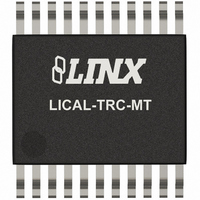LICAL-TRC-MT Linx Technologies Inc, LICAL-TRC-MT Datasheet - Page 12

LICAL-TRC-MT
Manufacturer Part Number
LICAL-TRC-MT
Description
IC TRANSCODER MT BI-DIR 20-SSOP
Manufacturer
Linx Technologies Inc
Series
MTr
Type
Transcoderr
Specifications of LICAL-TRC-MT
Package / Case
20-SSOP
Applications
RF, IR
Mounting Type
Surface Mount
Supply Voltage (max)
5.5 V
Supply Voltage (min)
2 V
Maximum Operating Temperature
+ 85 C
Minimum Operating Temperature
- 40 C
Mounting Style
SMD/SMT
Lead Free Status / RoHS Status
Lead free / RoHS Compliant
Lead Free Status / RoHS Status
Lead free / RoHS Compliant, Lead free / RoHS Compliant
Other names
LICAL-TRC-MTTR
Available stocks
Company
Part Number
Manufacturer
Quantity
Price
TYPICAL APPLICATIONS
Figure 11: MT Series Transcoder Application Circuit
Page 22
VCC
The MT Series transcoder is ideal for replicating button presses for remote
control applications. An example application circuit is shown below.
SPDT switches are used to select the baud rate and set the latch mode. These
can be tied directly to supply or ground if they will not change.
The TR_PDN line can be connected to the PDN line of a transceiver or it can be
left floating.
SER_IO can be connected to a microprocessor or a PC to program the
transcoder through the serial command set or to record the transmitter identity.
Application Note AN-00157 has sample code.
A LED indicator is attached to the MODE_IND line to provide visual feedback to
the user that an operation is taking place. This line will source a maximum of
25mA, so the limiting resistor may not be needed, depending on the LED chosen
and the brightness desired.
The CONFIRM line is connected to a LED to indicate that the remote device
successfully received the command.
The CRT/LRN and ENC_SEL lines are connected to buttons that will pull the
lines high when pressed. Since the lines do not have internal pull-down resistors,
a 100kΩ resistor is used to pull the line to ground when not in use.
The TR_DATA line is connected directly to the data line of the transceiver.
Data Lines D0 through D7 can be individually set up as either inputs or outputs.
In this example, D4 and D5 have buttons connected to them, so they will be set
up as inputs, and D0 and D6 are set up as outputs. D0 is connected directly to
a piezoelectric buzzer. Line D6 will activate a relay through a transistor buffer
when it goes high. A buffer like this may be needed if the load requires more than
25mA of current or a higher voltage source to activate. The transcoder will turn
on the transistor, which can be selected to provide the appropriate drive levels
to activate the relay.
100k
100k
VCC
VCC
To Processor or PC
To Transceiver
10k
To Transceiver
To Transceiver
2.2k
VCC
10
1
2
3
4
5
6
7
8
9
VCC
D6
D7
CRT/LRN
ENC_SEL
SER_IO
CONFIRM
TR_PDN
TR_SEL
TR_DATA
LICAL-TRC-MT
SEL_BAUD
MODE_IND
LATCH
GND
D5
D4
D3
D2
D1
D0
20
19
18
17
16
15
14
13
12
11
100k
100k
VCC
VCC
VCC
VCC
DESIGN STEPS TO USING THE MT SERIES
Creation of an Address and assignment of status lines
1. Take the CRT/LRN and the ENC_SEL lines high at the same time to enter
2. The Address will be randomized for as long as the CRT/LRN line is high (the
3. Release the CRT/LRN line and the MODE_IND line will begin switching to
4. Take each line that is to be an input high within fifteen seconds.
5. Take the CRT/LRN line high again or let the transcoder time out after fifteen
Learn another transcoder’s Address
1. Take the CRT/LRN line high then low to enter Learn Mode.
2. The MODE_IND line will begin switching to indicate that the transcoder is ready
3. Take the CRT/LRN line high again or let the transcoder time out after fifteen
Erase all Addresses in memory
1. Take the CRT/LRN line high and hold for ten seconds.
2. The MODE_IND line will go high when the CRT/LRN line is activated, then go
Communicate through the serial interface
1. Take the CRT/LRN line and the SER_IO line high at the same time to enter
2. Use a microcontroller or serial interface to write the desired serial command to
3. Read the acknowledgement and response (if there is one) from the transcoder
Create Mode.
ENC_SEL is not monitored once Create Mode has been entered). The
MODE_IND line will go high to indicate that the Address is being randomized.
indicate that the transcoder is ready to set status line assignments.
seconds to exit Create Mode.
to receive a transmission. On the transmitting side, activate each status line that
is to be authorized. The transcoder will record the Address and the activated
status lines as the Control Permissions.
seconds to exit Learn Mode.
low after ten seconds to indicate that the memory has been erased.
Serial Mode.
the transcoder LSB first with 1 start bit, 1 stop bit, and no parity at the baud rate
determined by the SEL_BAUD line.
LSB first with 1 start bit, 1 stop bit, and no parity at the baud rate determined by
the SEL_BAUD line.
Page 23















